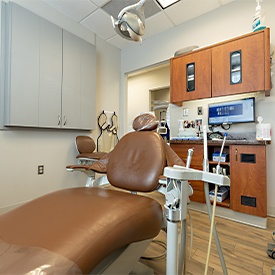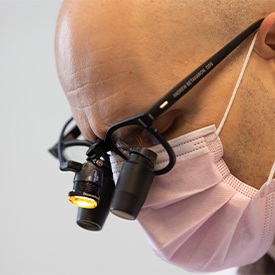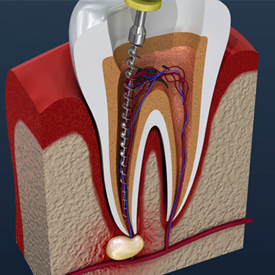 La Plata
La PlataDental
 La Plata
La Plata
 Teeth are composed of two main parts and three layers. The top of the tooth or the crown is the part that’s visible above the gums, and the root canals anchor teeth into the jaw. The outer layer of the tooth is called enamel. Beneath the tooth enamel, there is a supportive structure called dentin, and in the center of the tooth is a soft substance, pulp, that houses the nerve system of the tooth. The very inner pulp layer of tooth roots is called the root canal, and it allows the tooth’s nerve to connect with the rest of the body. When damage or decay accesses the nerve system housed within this pulp, we may say a patient needs a root canal or root canal therapy. This procedure calls for the removal of the damaged pulp and nerve tissue. The tooth is then refilled with a similar substance. Finally, any access points where the pulp was extracted are resealed, and we will often place a dental crown over the treated tooth for added strength. If you have a severe toothache, sensitivity to temperature changes, dark spots on teeth, or infection in the gums, you may be in need of a root canal to preserve your tooth.
Teeth are composed of two main parts and three layers. The top of the tooth or the crown is the part that’s visible above the gums, and the root canals anchor teeth into the jaw. The outer layer of the tooth is called enamel. Beneath the tooth enamel, there is a supportive structure called dentin, and in the center of the tooth is a soft substance, pulp, that houses the nerve system of the tooth. The very inner pulp layer of tooth roots is called the root canal, and it allows the tooth’s nerve to connect with the rest of the body. When damage or decay accesses the nerve system housed within this pulp, we may say a patient needs a root canal or root canal therapy. This procedure calls for the removal of the damaged pulp and nerve tissue. The tooth is then refilled with a similar substance. Finally, any access points where the pulp was extracted are resealed, and we will often place a dental crown over the treated tooth for added strength. If you have a severe toothache, sensitivity to temperature changes, dark spots on teeth, or infection in the gums, you may be in need of a root canal to preserve your tooth.

The inner area of teeth (known as the pulp) can be complicated and difficult to maneuver when you don’t know what to expect prior to treatment. Additionally, it’s incredibly important to remove all infected tissue and bacteria in order to prevent the risk of the tooth becoming infected again later. That’s why, as part of your diagnosis and in preparation for treatment, we capture detailed 3D images of your mouth via our in-house CBCT scanner. This makes it easier to confirm the need for root canal therapy and make the process more predictable overall.

A root canal is possibly the most dreaded dental procedure of all. But you'll be glad to know that with modern dental anesthetic and techniques, they're much easier than people think. Since it's quite common to have questions about this procedure, we've put together answers to the root canal FAQ's we hear the most. Our goal is to help you understand what you can expect beforehand so you feel as comfortable as possible. And if you have any other questions, don't hesitate to contact our office!
It's possible that the reason so many people think root canals are painful is that they were once done at a time when dentists didn't have the same effective anesthetic that we have today.
At La Plata Dental, the first thing we'll do is make absolutely sure that you're completely numb. Once that's done, you won't feel anything for the rest of your appointment. And, if you have extra fear or anxiety, you always have the option of sedation. Ultimately, your comfort is our top priority during every procedure, including root canals.
While we certainly have great tooth replacement options like dental implants, nothing is quite as good as your own teeth. And once they're gone, they're gone. That's why we always recommend saving natural teeth whenever possible.
Not to mention that after an extraction, you're faced with the choice between extensive dental work to replace your tooth and leaving an empty space. A missing tooth increases the chance of problems later on like gum disease or cavities in your remaining teeth as well as bite and alignment issues.
With all of that said, each situation is unique. Once we've evaluated your age, general health, budget, and goals, we'll make the best recommendation for your personal circumstances.
Usually, yes. Typical dental plans cover root canals at 50%-90% (after the deductible has been met). Since there's so much variation between plans, start by looking at your coverage. Insurance can be hard to understand, so you can also call us any time and we'll be happy to help. We can even file a preauthorization with your insurance company, which is a formal estimate of how much they’ll pay for your root canal. This is a great way to take the guesswork out of your fees to help you budget accordingly.
A root canal is necessary when you have an infection in the pulp and nerve canal of your tooth. Just like infections in any part of your body, it's extremely important to treat it to keep it from spreading. In fact, in rare cases, untreated dental infections can spread to the brain and can actually be fatal if not treated.
While that's the worst-case scenario, failing to get a root canal will (at the very least) lead to a severely painful toothache. Anyone who's ever experienced one would agree that they don't want to go through it a second time.
And, again, although you do have the option of an extraction instead of having a root canal, we only recommend that as a last resort.